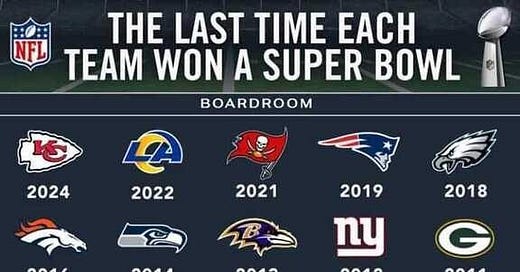One of my most vivid memories as a kid was the spontaneous block party that broke out across the neighborhood after the 49ers first Super Bowl win. The entire community spilled out into the streets to celebrate. Doors were flung open and stayed that way for hours while kids like me wandered from one stranger’s house to another. There were fireworks, hugs and lots of smiles.
As I grew up I got to celebrate 49ers championships four more times, but they was nothing was like that first one in 1982. Every fan base should get to experience it…eventually.
Unfortunately, on the eve of Super Bowl LX, fewer fans than we would expect have been able to hang the banner and party like its 1982.
After tomorrow’s game the NFL will have thrown 59 of these pigskin pageants, but crowned just 20 unique champions. Over a third of the league’s fan bases have never celebrated the sport’s ultimate victory.
I saw this meme floating around X, and it struck me just how few new champs we’ve had in recent years.
It wasn’t always this way. From 1998-2003 five different franchises who had never won a Super Bowl took home the Lombardi.
Denver had gotten to the big game in 1986, ‘87 and ‘89 and lost each time. In 1998 the Broncos finally won one for John. Then they repeated in 1999 and won one for Pat.
In 2000 the Rams — then in St. Louis — broke the seal behind a former grocery store clerk named Kurt Warner and the rest of the Greatest Show on Turf. The Ravens followed in 2001, Tom Brady and New England won their first in 2002. Then in 2003 Tampa Bay stole Coach Chucky from the Raiders and parlayed it into a Lombardi win against that same franchise. Epic stuff.
These were the Oprah “And you get a championship” years. The only comparable period was from 1968-1975, a nine-year span where seven teams won their first Super Bowl. (Though that’s misleading, since those were Super Bowls II through IX. Odds were pretty good that you get a new champion each year when you’re starting something from scratch.)
The run of new champions from 1998-2003 seemed to cement the idea that the recent changes the league had made to try and stop dynasties from forming — free agency and the salary cap being the most prominent — were having the desired effect. The NFL had gone from a league known for “Teams of the Decade” like the Packers, Steelers and 49ers, into one where any franchise had a shot. Or so we thought.
Then the drought began. From 2004 through the game tomorrow night that will be seen by much of the world, just three new franchises have won a championship: The Saints in 2010, the Seahawks in 2014, and the Eagles in 2018. The rest of the winners have been repeats.
That seems low to me, so I simulated the past 59 seasons 10,000 times under the assumption of perfect parity to figure out just how many unique champions we’d expect if every team had the same chance to win each year.
The answer, or at least the mean, is 27. But what’s interesting is that under the assumptions of a perfectly even playing field, there is no world where we would see just 20 unique champions over a 59 year period.
Put another way, we’re 7 franchises under expected through 59 years of Super Bowls. Clearly the NFL is not a league of perfect parity.
I also wondered if the salary cap had helped level the playing field in a way that increased the likelihood of a new franchise winning a Lombardi. To test, I divided the Super Bowl era into pre-cap and post-cap eras, and counted the number of franchises that won a championship in each.1
From 1966-93, the NFL produced 12 new champs. In a world of perfect parity thats six less than we’d expect on average. And again, there were zero simulations where just 12 teams were winners.
Moving to the cap era, we have 15 unique winners (though just 8 franchises won for the first time if you look at the entirety of the 59 year period). The simulations imply that we should expect 20 or 21 “unique” champs over the period.
In a slight difference from the previous era, though, 0.25% of the simulations under perfect parity ended up with 15 unique champs, implying that there’s a 99.75 percent chance there is not perfect parity in the current system.
Another way to summarize things is to measure the number of unique champions above or below expected. For the pre-cap era, there were 5.72 unique champs under expected. In the salary cap era, there were 5.41 unique champs under expected.
The difference between the eras comes to around a third of a unique championship, with the salary cap era closer to what we’d expect from a league of parity compared to the pre-cap era.
Not a large difference, but its’ something I suppose. Maybe. Clearly we’re nowhere near the ideal when it comes to competitive balance.
So what can be done about it?
I have a couple (likely deeply unpopular) ideas. I’ll return with those tomorrow before kickoff.
For whatever reason I wrote 60 instead of 59 multiple times in these articles. Corrected.
To clarify, if a franchise won a Super Bowl in one era, they would still count as a “new” winner if they won a Super Bowl in the other. I also counted teams that moved around from city to city as one franchise, like the Rams and the Raiders.







